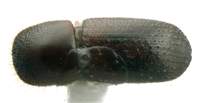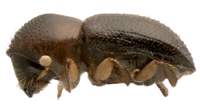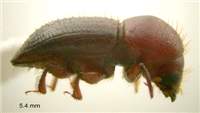Diagnosis
Robust, dark-colored. Usually diagnosed by tall pronotum with inflated anterolateral corners (=subquadrate in dorsal profile) and elytral declivity laterally broadened. Pronotum not always subquadrate. Large species with protibiae triangular, with few large denticles, smaller species with protibial edge rounded, with numeorus small denticles. Antennal club usually type 3, with first segment straight, and segments 2 and 3 visible posteriad.
Distribution
South Asia and Oceania, rare in temperate East Asia. One species recently introduced to North America.
Biology
E. destruens is capable of attacking live trees, occasionally causing damage in plantations. E. fornicatus also tea plantations. Large species breeding in tree trunks, small species often in twigs.
Taxonomy
Designated by Hopkins (1915), significantly broadened and made polyphyletic by Wood & Bright (1992), split into Euwallacea, Wallacelus and Planiculus by Hulcr & Cognato (2010).
Detailed description
Eyes shallowly emarginate, upper part smaller than lower part, or as large as lower part. Antennal club approximately circular, club type two (obliquely truncated, segment 2 visible on posterior side), or three (with segment 1 straight or convex). Segment 1 prominent, covering most of anterior side and nearly entire posterior side, its margin concave, fully costate. Segment 2 visible on both sides of club, but soft, or partly corneous on anterior side, or corneous on both sides of club, but not entirely circular. Segment 3 partly or clearly visible on both sides of club. Segment 1 of antennal funicle shorter then pedicel, in large species longer with stalk-like base. Funicle 4-segmented, scapus regularly thick. Frons above epistoma rugged, coarsely punctate. Submentum slightly impressed, shaped as very narrow triangle. Anterior edge of pronotum with no conspicuous row of serrations (serrations don't differ from those on anterior slope). Pronotum from lateral view tall (type 2), from dorsal view subquadrate (type 3), or quadrate, robust (type 4). Pronotal disc smooth, alutaceous, or densely and evenly punctured, lateral edge of pronotum obliquely costate. Procoxae contiguous, prosternal posterocoxal process short or tall, and inconspicuous to pointed or slightly inflated. Tuft on pronotal basis associated with mesonotal mycangium absent, setae on elytral bases associated with elytral mycangium also absent. Scutellum flat, flush with elytra. Elytral bases straight, with oblique edge, elytral disc longer than declivity, flat or slightly convex, punctures on elytral disc in distinct strial lines. Boundary between elytral disc and declivity indistinct, end of disc rounded and smoothly transitioning into declivity. Lateral profile of elytral declivity slowly descending, often flat. Elytral apex broadened and flattened laterally. Posterolateral declivital costa ending in 7th interstriae. Surface of declivity with few setae or scales, not conspicuously pubescent. Interstriae on declivity mostly with regularly spaced setae-bearing granules. In large species, granules are abundant, making declivity appear rugose. First interstriae parallel. Protibiae in large species distinctly triangular, slender on upper part, broad and denticulate on lower part, in smaller species broad, with evenly rounded edge. Posterior side of protibia flat, no granules, only setae. Protibial denticles in large species large, distinctly longer than wide, bases of denticles distinctly enlarged, conical, fewer than 6 protibial denticles present. In smaller species denticles small, sockets slightly enlarged, more abundant. Size variable, 2.8-5.7 mm. Color uniform, brown to black.




